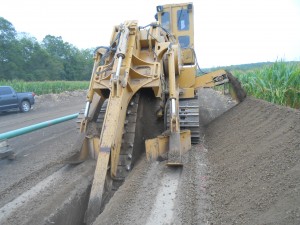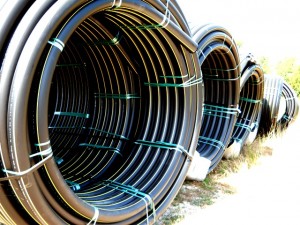May 2013, Vol. 68 No. 5
Features
Gas To The Ozarks

For homeowners and businesses that have natural gas service, this economical and dependable source of energy is taken for granted for heating, hot water supplies and often for cooking.
Yet for various reasons, many areas in the country remain without access to gas, and news that gas is coming to a well-known area is often a surprise to residents of nearby areas who are longtime gas customers.
Summit Natural Gas (SNG) is nearing completion of a project that ultimately will place 2 million feet of HDPE natural gas pipe in the ground to serve the popular Missouri Lake of the Ozarks vacation and resort area about three hours southeast of St. Louis. With a shoreline of more than 1,150 miles, the lake and surrounding areas offer boating, fishing golfing, shopping and a wide variety of lodging, restaurants, state parks and other recreational activities.
When completed, the new natural gas network will provide gas to the towns of Gravois Mills, Laurie, Sunrise Beach, Camdenton, Osage Beach and Lake Ozark.
The Summit project is the second largest construction project ever undertaken in the area — after construction of the 54 Expressway, said Bret Brown, Summit director of Missouri business development.
New arrival
Gas has been a long time coming to the areas. The terrain, the rock, cost of construction and lack of records of existing buried utilities discouraged others from attempting to bring gas to the region, said Brown.
Planning to bring gas to the Lake of the Ozarks began in 2008 with surveying, right-of-way acquisition, designing and mapping the route of underground pipe infrastructure, hiring contractors and marketing the new service to prospective customers.
Overall, 70 percent of the new gas system will be installed by the trenchless method of horizontal directional drilling (HDD) with the remaining 30 percent open-cut.
To bring gas to the Lake of the Ozarks area, a 49-mile, six-inch diameter steel transmission line had to be constructed from Lincoln, MO, along right-of-way of a power line easement.

“The Ozarks are extremely hilly, with steep terrain and a lot of hard rock,” Brown said. “There’s only a couple of inches of top soil and below that is solid rock.”
Construction began in July 2012. The six-inch transmission line was installed primarily by open cut construction, said Brown.
“Ninety percent was open-cut with pipe buried to depths providing four-feet of cover above the pipe,” Brown said. “The other 10 percent was installed by horizontal directional drilling, primarily road and river crossings and the three long lake bores. For excavation, two 440-horsepower, 150,000-pound Tesmec M5 trenchers were used.
Along the route of the transmission line will be seven regulation stations to regulate the pressure of the natural gas as it passes from the steel line into the distribution lines.
Essential bores
Critical elements of the six-inch transmission line are three bores under the lake, all in the last 10 miles of the steel transmission line.
The water crossings were at three primary bridges: a 3,400-foot long bore at Niangua Bridge; 5,800 feet under Hurricane Deck Bridge; and a crossing of 3,700 feet at Community Bridge. Depth of the lake bores will average 80-feet through rocky conditions.
“The most difficult parts of the project are installing the steel pipe through the extreme hills and under the lake,” said Brown. “Soil data gathered during construction of the bridges helped designers plan for conditions the bores would have to pass through.”
J.F. Construction Services, DeWitt, MO, subcontracted the lake crossings. A one-million-pound pullback Vermeer D1000x900 HDD unit will make each bore. An 11¼ -inch bit provides a pilot hole large enough to install pipe without backreaming. Plans call for all bores to be surface launched, exiting on the opposite side of the lake.
For each installation the six-inch steel pipe was welded into a single string along the road. Space is tight, but crews must work with the area available, Brown said.

The 3,400-foot Niangua Bridge crossing was made first. “There were no surprises or complications that the crews were not able to deal with,” said Brown. “With the Niangua bridge bore complete, crews moved to the toll bridge for the second lake bore.”
Meanwhile, installation of distribution pipe continues. The distribution network will consist of 2 million feet of HDPE. Of that total, there will be 4,865 service lines in pipe sizes ranging from 3/4 inch to two-inches, depending on customer requirements. Distribution pipes range in size from two to 8-inches in diameter.
Collection of subs
“Eighty percent of distribution pipe will be installed by directional drilling,” said Brown. “It is the only method that could be used because of all the existing utilities, driveways and areas paved with concrete and asphalt. Also, there was not enough space to bring large trenchers in and the rock was a key factor.”
Eight subcontractors employing 30 HDD machines are installing distribution pipe. “We believe we have assembled the best contractors in the industry,” said Brown.
Drilling equipment used in distribution construction includes Ditch Witch JT3020 and JT4020 All Terrain machines equipped for rock drilling and Vermeer D24x20, D20x22, and D36x50 equipment.
Drilled routes are in residential and commercial areas along utility easements and street right-of-way, across streets and highways, under lawns and landscaping.
The Summit gas system is expected to be completed the end of December 2013. By March 1, Brown estimated that 70 percent of the transmission line and 50 percent of the distribution system were complete. The first areas began live gas in February. The system is projected to serve approximately 4,800 customers and by the end of February, more than 2,200 had signed on for service.
Summit Natural Gas of Missouri Inc., formerly known as Missouri Gas Utility and Southern Missouri Natural Gas, provides natural gas service to customers in portions of Northwestern, Southwestern and Central Missouri. Summit Natural Gas currently serves over 11,000 customers and continues to add areas that currently are not served by a natural gas utility.
FOR MORE INFO:
Summit Utilities, (800) 720-8193, www.summitutilitiesinc.com
JF Construction Services LLC, (660)549-3390, www.jfconst.com
Tesmec USA, (800) 851-5102, www.tesmec.com
Ditch Witch, (800) 654-6481, www.ditchwitch.com
Vermeer Corp., (888) 837-6337, www.vermeer.com




Comments